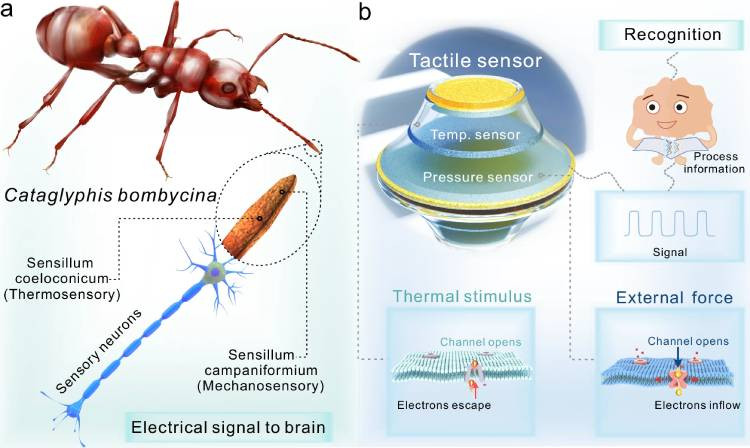Triboelectric Tactile Sensor for Next-Gen AI Robotics Systems
11-02-2025 | By Liam Critchley

Key Things to Know:
- Triboelectric Tactile Sensors for Extreme Environments: New multi-modal triboelectric nanogenerator (TENG)-based sensors can detect both pressure and temperature, extending beyond human tactile perception limits.
- Inspired by Nature: Researchers took inspiration from silver ants, which thrive in extreme heat, to design TENG sensors with enhanced resilience and adaptability for high-temperature environments.
- AI-Enhanced Sensor Accuracy: Machine learning integration allows TENG sensors to adjust to temperature variations in real time, ensuring consistent and precise performance in fluctuating conditions.
- Broad Applications Beyond Robotics: TENG-based tactile sensing is being explored for prosthetics, wearable technologies, and space exploration, offering enhanced sensory feedback and multi-stimuli detection.
The era of artificial intelligence (AI) and intelligent technology is upon us. Advances in AI are providing a new era for robotic technologies that are more intelligent and more human-like than ever before. One of the main areas of robotics that requires a lot of work are the tactile sensors that mimic human motion, touch and feel. Tactile sensing in humans is a complex network of receptors that provide electrical signals to the brain. While this can be recreated artificially, getting robots to perceive and analyse external stimuli to interact with their environment is a technically challenging endeavour.
Building an advanced perception for robots to survey and interact with their environment requires highly sensitive and robust tactile sensors that can respond to multiple stimuli. There are various tactile sensors being developed that work on different mechanistic principles―such as piezoelectric, piezoresistive, mechanoluminescent, pyroelectric, and capacitive sensing―and all detect physical stimuli. The majority of tactile sensors operate at room temperature and work at elevated temperatures (and in harsh temperature conditions), which is typically beyond the capabilities of robotic tactile sensors today.
However, skin-like sensors that can detect multiple stimuli simultaneously have a lot of potential in the latest human-machine interaction technologies. So, there’s a lot of interest for developing more advanced tactile sensors, and researchers have turned to creating tactile sensors based on the triboelectric effects to overcome the temperature restriction of robotic tactile sensors.
Limited Temperature Operation Range of Tactile Sensors
Many research studies have focused on developing tactile sensors that operate at room temperature. While there are plans for robotics in everyday atmospheric conditions, the lack of multi-modal sensors that can operate in harsher temperatures limits the use of intelligent robotics in extreme environments where they might serve more of a purpose―such as in space, deep sea, and fire rescue applications―where it is too dangerous for humans to perform certain tasks.
There have been numerous developments over the years towards developing tactile sensors that mimic human tactile receptors and developing advanced materials that are not sensitive to temperature. However, many tactile sensors are still limited by the response mechanism when interfacing with the stimulus signal. This has meant that tactile sensing has been limited to the temperature range of a human touch―which is ≤60 °C.
Triboelectric Nanogenerators (TENGs) Have Shown Promise
Overcoming the challenges of the limited temperature range has required researchers to look at other mechanistic approaches. One approach is to use a triboelectric nanogenerator (TENG), which works by using the triboelectric effect. TENGs use contact electrification and electrostatic induction mechanisms to convert an external tactile stimulus into an electrical output. Because TENGs themselves are energy harvesting devices, they require no extra power modules to operate.
Recent advances in triboelectric nanogenerators (TENGs) have also explored the role of material composition in enhancing charge retention and stability under varying thermal loads. Studies indicate that the use of high-temperature-resistant polymers, such as fluorinated ethylene propylene (FEP), significantly improves the triboelectric output in extreme environments. This material innovation aligns with the broader trend of using bio-inspired design strategies to create more resilient and adaptable sensor systems.
It has been discovered that the transfer of triboelectric charges in the contact electrification mechanism exhibits a temperature effect where the temperature increase improves the electron emission capabilities across the triboelectric material―decreasing the electrical signal of the TENG. This temperature dependence of the electrical signal could allow robots to respond to tactile stimuli in high-temperature environments.
The unique capabilities of the Saharan silver ant, which can navigate and survive in extreme heat, have inspired researchers to develop high-temperature adaptive tactile sensors. By mimicking the biological mechanisms of these insects, scientists have designed TENG-based sensors that can perceive both pressure and temperature stimuli in extreme environments. The following figure illustrates the bio-inspired approach and the structural adaptation of the triboelectric sensor.

a The Saharan silver ant's nervous system enables dual sensory perception, detecting both pressure and temperature in extreme heat. b Triboelectric sensor-generated signals are utilised in machine learning to enhance object recognition capabilities.
Enhancing TENG Sensor Accuracy with AI
Moreover, integrating machine learning algorithms with TENG-based sensors enables real-time adjustments to temperature-induced variations in signal output. By leveraging AI-driven predictive modelling, researchers have improved the accuracy of TENG sensors in extreme environments, ensuring consistent performance even when exposed to fluctuating thermal conditions.
Work has already been done on developing self-powered tactile sensors using TENGs, but they have not yet been explored for extreme temperature applications.
Triboelectric Sensing for Extreme Environments
The potential for TENG-based tactile sensors extends beyond high-temperature applications. Research has demonstrated that triboelectric mechanisms can also be adapted for use in low-temperature environments, such as space exploration, where extreme thermal fluctuations occur. The ability to maintain sensor accuracy across a broad temperature range underscores the adaptability of triboelectric systems in next-generation robotics.
Developing High-Temperature TENG-Based Sensors
However, the development of TENG sensors and the understanding of the TENG mechanisms under a temperature load have shown that TENG-based tactile sensors are theoretically feasible for high temperature applications. Building on the work done in the field, researchers from Guangxi University have developed a high temperature TENG-based tactile sensor for advanced robotic applications.
In addition to thermal resilience, the latest developments in TENG-based tactile sensors have shown improved spatial resolution, allowing robots to distinguish between fine pressure variations with greater precision. This advancement is crucial for applications in hazardous environments, where robots must handle delicate materials or perform intricate tasks without human intervention.
Triboelectric Tactile Sensing Beyond Room Temperature
Researchers have now developed a multi-modal triboelectric sensor that can detect both pressure and temperature beyond the limits of human tactile perception limits. The work took a biomimicry approach and was inspired by silver ants (Cataglyphis bombycina), as these insects can perform and maintain multi-sensory perception in high-temperature environments.
Biomimicry and Nature-Inspired Sensor Design
The sensor uses a TENG composed of stable cellulosic triboelectric materials to achieve this dual sensing capability. Taking inspiration from biological mechanisms, the TENG was used to independently output dual pressure and temperature signals by converting the different feature matrices and performing a parallel perception of complex objects being grasped by the tactile sensor. Biological organisms close and open their ion channels in response to physiological electric signals, and the approach using TENGs mimics this approach to facilitate environmental perception and sense pressure and temperature at high temperatures.
Beyond robotics, the principles of triboelectric tactile sensing are being explored for wearable technologies and medical applications. Research suggests that TENG-based sensors could be integrated into prosthetics, providing enhanced sensory feedback for users by mimicking human-like tactile perception in real time.
Performance Metrics: Speed, Accuracy, and Thermal Resilience
The tactile sensor developed had a recognition rate of 94%, a fast stress response time of 70 ms, a fast recovery time of 58 ms, and a wide detection range. The sensor possessed temperature sensing capabilities beyond the human upper limits of 60 °C, with an operating temperature of 200 °C. These properties are due to the combination of the asymmetric design and the use of heat-resistant sensing materials.
The TENG tactile sensor was also integrated into a robotic hand and provided real-time responses to both pressure and temperature at high temperatures. The triboelectric signals were also enhanced with machine learning to improve object recognition capabilities.
Future Prospects and Research Directions
The combination of a high operating temperature range with real-time digital response and no need for an external power source means that TENG-based tactile sensors could be a viable option for intelligent robotic systems that are to be used in harsh environments. The sensor could potentially open a range of possibilities for human-machine and machine-environment applications. The developments are still in the early stages, and further improvements could still be made to the sensing capabilities in future research.
Reference:

